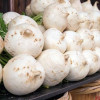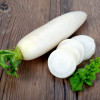Popular varieties of Daikon radish
Content
Elephant fang
There are more than 400 varieties and hybrids of daikon in the world, and most of them have similar characteristics, since one species served as the basis for their breeding. This made it possible to distinguish seven main groups in the classification of Japanese radish, depending on the ripening period, taste, external and commercial characteristics of root crops. It should be clarified that there are some original varieties that are grown exclusively in the homeland of the culture, and there are local hybrids bred for the climate of a particular country.
"Fang of an elephant" is one of the hybrids which, inIt was bred by breeders of the Kuban, where at first it was zoned, but then quickly spread throughout the country, and now it is the most popular and demanded domestic variety.
According to the ripening period, it is considered mid-season, ready for harvesting in 75-90 days. Root crops are long (more than 20 cm), cylindrical, medium or large in size (weighing 400-500 g, and 8-10 cm in diameter), white. The pulp is very juicy, crispy, sweet, with a slight bitterness in the aftertaste. The variety is suitable for winter use, since the roots are well stored and do not lose their taste for a long time.
It should be noted a few more hybrids of domestic selection that are similar to the above-described variety:
- “White Fang” is a mid-season variety (70-80 days). Root crops are elongated, conical in shape, of various sizes (from 200 to 500 g, from 20 to 50 cm long), the peel and pulp are white. The taste is very delicate, sweet, with a slight bitterness. The yield of the variety is quite high, the shelf life is more than 3 months.
- Daikon "Japanese Long" is a late-ripening (80-90 days) high-yielding hybrid, not prone to shooting arrows. Root crops are long (40-60 cm), large (up to 3 kg), white, elongated, slightly pointed towards the bottom. The pulp is dense, slightly pungent taste, has high healing properties. Root crops retain marketability, taste and juiciness for a long time.

- Daikon "Big Bull" also belongs to white varieties of domestic selection. In terms of ripening, it is medium early (50-60 days). Root crops are very large, can grow up to 2-3 kg, oval-elongated in shape, pointed at the bottom, wide at the base. The pulp is dense, juicy enough, of high taste. The commercial qualities are high - all vegetables are even, the peel is smooth, stored and transported well, and have high medicinal properties.
- Daikon "Russian size". From the two previous varieties, this one differs in an early ripening period (40-45 days) and very large root crops (more than 50 cm in length and 12 cm in diameter). The shape of the root crops is elongated, pointed towards the bottom, the color is white, the peel is smooth. The pulp has a soft, slightly pungent taste, retains juiciness for a long time. Suitable for spring and summer planting, the yield is high.The recommended planting pattern is 60x40, at this distance the roots reach their maximum size.
With the same frightening name "Russian size F1" there is another type of daikon. This is a hybrid with rather large (2-2.5 kg) roots up to 14-16 cm in diameter. This daikon has a red skin and looks like a round Chinese radish. Differs in a particularly soft, sweetish taste without bitterness. Ripens early - 35-40 days after planting.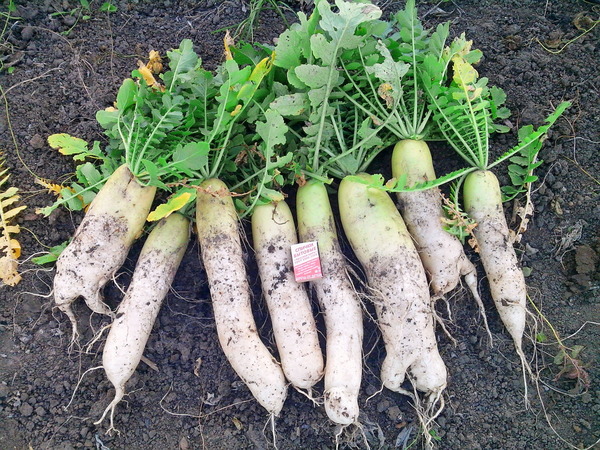
Do not disregard the domestic selection of daikon "Sasha", which also belongs to the white radish. This is an early ripe hybrid (35-45 days) with high immunity to cold and disease. The root vegetables are round, white in color, greenish on top, due to which many think that this is a turnip - daikon Sasha really has the shape of a turnip, but its taste is not at all spicy, but even sweet.
Video "The best varieties of daikon"
From the video you will learn about the fruitful varieties of radish.
Minovase
An extensive group of mainly early-ripening and mid-ripening varieties with white roots. Daikon of the “Minovase” variety is distinguished by a particularly high resistance to disease, heat and drought. This species, even in abnormal heat conditions, does not release arrows, for which it is highly valued by vegetable growers in the southern regions. A distinctive feature of this type of radish is the even, cylindrical in the upper part, and the elongated-conical shape of the root crops in the lower part. To grow Minovase, you need a light sandy loam soil enriched with organic matter. The culture is not demanding to care, but periodically it is necessary to huddle the root crop, since the daikon is immersed in the soil only by a third.
Of all the varieties of Minovase, only a few varieties are cultivated in our country, among which are especially popular:
- Minovase long - mid-season (60-70 days) variety with rather large (50-60 cm), elongated, cylindrical roots, resistant to flowering, delicate taste, without bitterness and burning aftertaste;
- Minovase Summercross F1 is an early ripe (40-50 days) hybrid intended for spring sowing, resistant to flowering and drought, elongated fruits, very large (up to 4 kg), excellent mild taste, with a long shelf life.
Japanese early
This is perhaps the most popular and most cultivated variety in summer cottages. Gardeners love it for its early (40-45 days) ripening, and relatively small (250-500 g), elongated, white roots. It is this type of daikon that is most often found in supermarkets and vegetable markets, since it lasts for a long time, and if planting is carried out in the fall, then you can feast on root crops even in winter.
An early daikon can be planted as soon as the snow melts, and in the greenhouse - at the end of February, which allows you to get a useful product at a time when even the greenhouse radish is not yet ripe.
The variety is completely unpretentious, easily tolerates night frosts and can grow in any soil. But besides all these positive characteristics, the product is especially appreciated for its healing properties and rich vitamin composition.
Tokinashi
Daikon of this type is of the most genuine oriental origin. In Russia, it is not yet very common, and as a vegetable crop is grown as a test, but this does not prevent some summer residents from sowing Tokinashi in their gardens. A distinctive feature of the variety is that, despite its early ripening, it is all-season - suitable for planting at any time, since it has a very high resistance to the formation of arrows.
Tokinashi root vegetables have high medicinal properties and excellent soft taste. It will be fair to say that this daikon, whose external description is not as attractive as its taste (the roots do not differ in an even shape), grows better in light sandy loam or loamy soil. Taking care of him is not difficult at all. Since its growing season is rather short, there is no need to feed the plants.Periodic watering, removing weeds from the garden - that's all that a crop needs. And if you take proper care of the cultivation of Tokinashi, the yield can be quite impressive.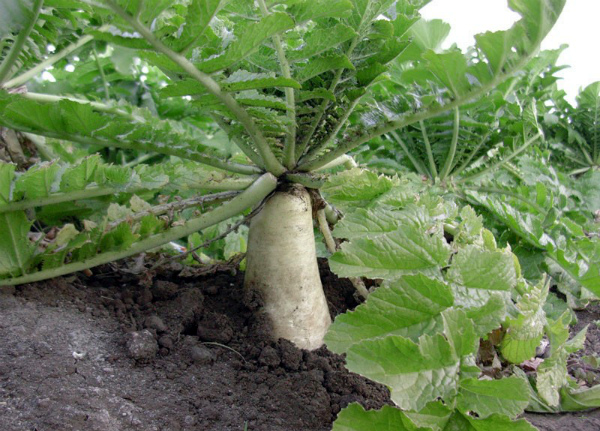
Another admirer of loose loamy soils is daikon Miyashige. It is an early variety intended mainly for spring production, but many growers practice planting at the end of August for the fall harvest. In Japan, Miyashige is one of the most popular varieties. Its roots are flat, cylindrical, pointed at the bottom, and pure white in color. The size of the vegetable is average (weight 200-400 g, length 30-45 cm), market characteristics and taste are very high. The variety is resistant to disease and flowering.
Kameida
This species includes a group of varieties characterized by relatively small (12-15 cm), white conical roots that look like carrots. The taste of Cameida is sharp, slightly spicy, so the roots are often cooked or salted. 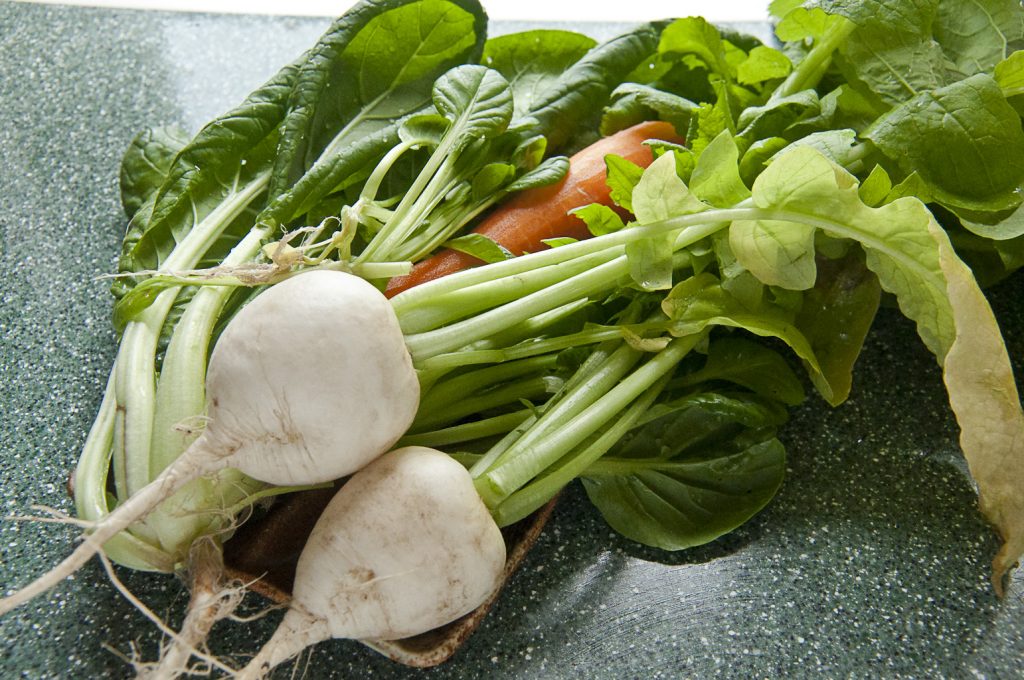 To grow Kameida varieties, you need light, fertile, sandy or sandy loam soil and regular watering. If these conditions are met, root crops grow very large and juicy leaves, which can also be eaten.
To grow Kameida varieties, you need light, fertile, sandy or sandy loam soil and regular watering. If these conditions are met, root crops grow very large and juicy leaves, which can also be eaten.
Video "How to sow radish correctly"
From the video you will learn how to sow seeds correctly in order to get a good harvest.

